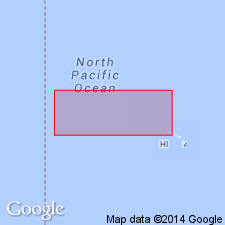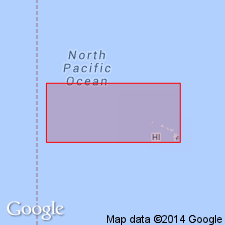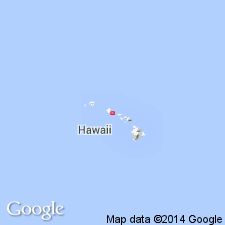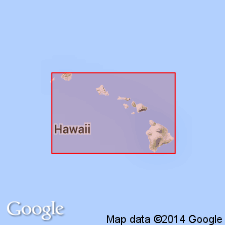
- Usage in publication:
-
- Kalihi volcanics*
- Modifications:
-
- Named
- Dominant lithology:
-
- Basalt
- AAPG geologic province:
-
- Oahu
Summary:
Named for occurrence in Kalihi Valley from crest of Koolau Range SW to sea [Honolulu 7.5' quad] Island of Oahu. Also may be in Manaiki Valley. Included as unit in lower part of Honolulu volcanic series. Composed of cinders more than 100 ft thick and dense columnar-jointed basalt 50 ft thick. Contains olivine inclusions 1 to 3 in across. Geologic section at Damon road cut is approx 49 ft thick. Locally overlies with erosional unconformity Koolau volcanic series Assigned middle(?) and late Pleistocene age.
Source: GNU records (USGS DDS-6; Menlo GNULEX).

- Usage in publication:
-
- Kalihi volcanics*
- Modifications:
-
- Age modified
- AAPG geologic province:
-
- Oahu
Summary:
Is lava flow of melilite-nepheline basalt and associated cinder cone remnant. Several ft of tuff at base contain fragments of underlying Koolau lavas. Boulders believed to be derived from Kalihi lava are intermixed with tuff believed to belong to Aliamanu eruption. Exposed over area about 1.7 sq mi along Kalihi Valley from crest of Koolau Range SW to sea about 14 mi W of Makapuu Head. Winchell (1947) believes Kalihi and Haiku volcanics probably erupted simultaneously. Assigned Pleistocene age.
Source: GNU records (USGS DDS-6; Menlo GNULEX).

- Usage in publication:
-
- Kalihi Volcanics*
- Modifications:
-
- Geochronologic dating
- AAPG geologic province:
-
- Oahu
Summary:
K-Ar ages on samples from Kalihi nepheline-melilite lavas range from 464 +/-22 ka to 457 +/-11 ka.
Source: GNU records (USGS DDS-6; Menlo GNULEX).

- Usage in publication:
-
- Kalihi Volcanics*
- Modifications:
-
- Geochronologic dating
- AAPG geologic province:
-
- Oahu
Summary:
K-Ar age on nepheline-melilite basalt from Kalihi vent gave calculated age of 0.58 +/-0.025 Ma.
Source: GNU records (USGS DDS-6; Menlo GNULEX).

- Usage in publication:
-
- Kalihi Volcanics†
- Modifications:
-
- Abandoned
- AAPG geologic province:
-
- Oahu
Summary:
Kalihi Volcanics (Stearns, IN Stearns and Vaksvik, 1935) abandoned as formally named unit and renamed Kalihi flow (and associated cone), informal unit of Honolulu Volcanics.
Source: GNU records (USGS DDS-6; Menlo GNULEX).
For more information, please contact Nancy Stamm, Geologic Names Committee Secretary.
Asterisk (*) indicates published by U.S. Geological Survey authors.
"No current usage" (†) implies that a name has been abandoned or has fallen into disuse. Former usage and, if known, replacement name given in parentheses ( ).
Slash (/) indicates name conflicts with nomenclatural guidelines (CSN, 1933; ACSN, 1961, 1970; NACSN, 1983, 2005, 2021). May be explained within brackets ([ ]).

